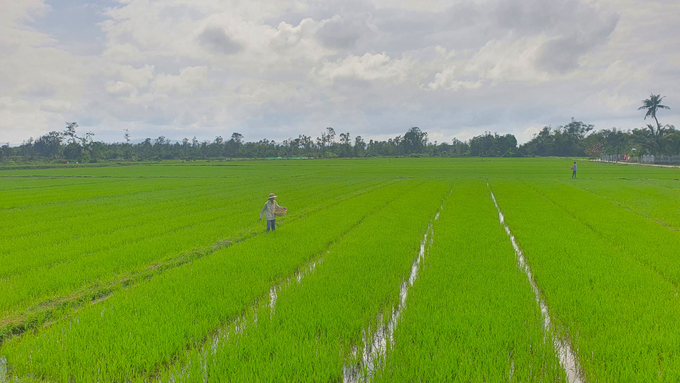
Many areas of winter-spring rice in Quang Nam are growing slowly due to the persistent cold and rainy weather. Picture: LK
From the sowing of the winter-spring crop until now, the weather in Quang Nam is not favorable for the development of rice plants, when many cold rains occur continuously and for a long time, causing rice growth to be slow. At the same time, harmful pests and diseases appeared.
According to the Ministry of Agriculture and Rural Development of Duy Xuyen District, the entire district is expected to plant about 3,500 hectares of rice in the winter-spring harvest of 2022-2023. So far, the community has settled about 70% of the area. Although rice has only been growing for a while, some fields have been damaged by rats. About 30 hectares of rice were bitten by yellow apple slugs, 10 hectares of rice were infected by sex flies, etc., and many other dangerous pests also appeared on young rice plants.
Mr. Nguyen Hoa (Hoa Lam Village, Duy Trung Township, Duy Xuyen) said that his family sowed 3 sao (500 m2) of rice for this year’s winter-spring harvest. “For the past few days, my wife and I have focused on pruning and fertilizing to help the rice plants recover and grow. Yellow apple snails, thrips, fruit flies… have been appearing in large parts of the rice area with increasing density in recent days. Seeing this, I bought special medicines for spraying. If this period is not closely monitored, when pests and diseases erupt heavily, the crop will definitely be lost,” Mr Hoa said.

The yellow apple snail appears to be destroying rice areas. Picture: LK
In Que Son District, 3,600 ha of winter-spring rice are currently in the pruning and tilling phase. However, small leaf rollers have appeared in open water paddy fields with a density of 2-4 insects/m2 and thrips in water-active paddy fields with a density of 400-500 insects/m2 at 700-1,000 elevations. children/m2. In addition, yellow apple snails, worms, rats… also cause damage, scattered over a number of paddy fields in many places.
According to Quang Nam Province Agricultural Statistics, the whole province has more than 102 hectares of rice so far, which mice eat seeds when they are sown; 145.5 ha of rice were damaged by the yellow apple snail; root nematode disease causing damage at a rate of 3-15% on 15 ha of activated paddy rice in Dai Loc district; Small leafrollers cause scattered damage to water-dependent paddy fields in Nong Son, Que Son, Tien Phuoc and Thang Binh districts.
With other crops such as peanut, root rot disease, seedling death, black mold root rot, white mold root rot, 41 ha were damaged in Duy Xuyen, Thang Binh, Nui Thanh, Que Son, Dai Loc. Node rot affects 8ha of fruiting stage peas – harvested in Dai Loc with a disease rate of 10-15% and root rot occurs on 5ha of late dwarf peas with a disease rate of 5-10%. Autumn acacia, leaf-eating caterpillars and gray caterpillars also cause isolated damage to corn plants in Dai Loc, Dien Ban and Nong Son.

People and professionals need to regularly inspect the field to detect pests and diseases and take timely preventive measures. Picture: LK
The Quang Nam Plantation and Plant Protection Agency recommends that in order to limit the harmful occurrence of yellow apple snails, it is best to use manual measures such as egg killing; Collect snails on fields, catch bats, dig trenches and destroy.
When the slug density in paddy fields is high, certain medicines can be used for spraying. Professionals and local authorities must continue to support and guide farmers to kill rats through many measures such as setting traps and baiting with biological and biochemical drugs.
Mr. Nguyen Xuan Vu, deputy director of the Ministry of Agriculture and Rural Development in Quang Nam, said the coming period will be favorable for the blast disease in infected rice varieties given the current weather conditions. Therefore, the team of agricultural technicians at all levels, agricultural advisors at the grassroots level, must regularly inspect the fields (for rice in the tillering stage – female standing) to detect diseases early and take appropriate measures. .
“For upland crops and legumes, especially in areas with large corn-growing areas, there is a need to proactively instruct farmers to regularly inspect their fields and take timely and effective fall worm control measures. For gray caterpillars, green caterpillars, leafworms and stem-biting caterpillars, manual measures such as egg collection and removal should be used at low densities. Only use pesticides for spraying unless the pest is at high density (spray when young),” noted Mr Vu.

